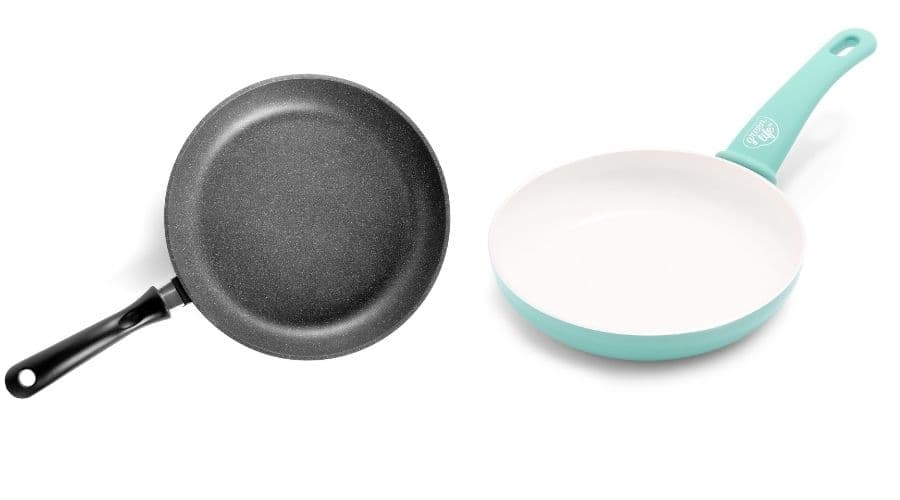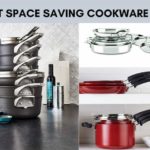Ceramic vs Teflon Cookware: The Pros & Cons

When it comes to nonstick cookware there are two main options, ceramic and Teflon.
Which is the better type of cookware to use—ceramic or Teflon? Both have their pros and cons, but which one is right for you?
In this blog post, we’ll take a closer look at ceramic vs Teflon cookware to help you decide which is right for you.
What Is Ceramic Cookware?
Ceramic cookware is made from a type of clay called kaolin. It is then fired in a kiln at high temperatures.
This transforms the kaolin into a ceramic material that is smooth and non-toxic. This makes it an ideal choice for cooking, as it is non-stick and very easy to clean.
Ceramic cookware has become increasingly popular in recent years as people have become more aware of the concerns about Teflon cookware.
It is a safe and healthy alternative to Teflon, as it does not release any harmful chemicals into food when it is heated.
Also Read: Best Non-Stick Pans without Teflon
Ceramic cookware is also very durable and long-lasting. It is a good investment as it will last for many years with proper care.
However, ceramic cookware can be more expensive than Teflon and it is also more fragile. It is important to take care when using and cleaning ceramic cookware to avoid damaging it.
Types of Ceramic Cookware
Pure Ceramic Cookware?
There is a new type of ceramic cookware on the market that is made from 100% ceramic. This means that there are no other materials such as aluminum or stainless steel used in its construction.
It is also free of toxins like lead and cadmium that are often found in other types of cookware material.
Pure ceramic cookware is made of all-natural clay, which gives it a more traditional and rustic look. When fired in a kiln, this type of ceramic cookware is very durable and resistant to scratching or damage from heat. It also tends to have excellent thermal properties.
Read More: Best Ceramic Cookware Made in USA
Glazed Ceramic Cookware
Glazed ceramic cookware is made from a combination of clay and other materials, such as glass or metal.
The glaze on this type of cookware provides additional protection against damage, while also making the surface non-stick and easy to clean.
However, some studies have shown that glazed ceramic cookware may leach trace amounts of lead and other heavy metals into food.
Ceramic Coated Cookware
Ceramic-coated cookware is made from aluminum or stainless steel, which is then coated with a layer of ceramic. This provides an effective non-stick surface, while also providing excellent heat distribution.
However, the ceramic coating on this type of cookware can chip or flake off over time, which means that it will need to be replaced more frequently than other types of cookware.
Advantages of Ceramic Cookware
Now that you know a little more about ceramic cookware, let’s take a look at some of the pros and cons of ceramic cookware:
- Ceramic cookware is safe and non-toxic. It does not release any harmful chemicals into food, even when heated.
- Ceramic cookware is available in a range of colors, so you can find one that suits your personal preferences.
- One of the biggest benefits of ceramic cookware is that it has a non-stick surface. This makes it very easy to clean and reduces the amount of oil or butter required when cooking.
- As it has an aluminum base, the heat is uniformly distributed throughout the cookware, so no hot spots are created. This means that food will not stick or burn to the surface of the cookware.
Disadvantages of Ceramic Cookware
Ceramic cookware is more expensive than other types of cookware, such as Teflon or stainless steel.
It is also more fragile and prone to chipping or cracking, so you need to take extra care when using it.
Overall, ceramic cookware is a good option if you are looking for a healthy and safe cooking surface. However, it may be too expensive or fragile for some people. Consider your needs carefully before deciding which type of cookware is right for you.
What Is Teflon Cookware?
Teflon is basically the brand name for the chemical polytetrafluoroethylene (PTFE). This material is a synthetic fluoropolymer that was originally developed by DuPont back in 1938.
It was originally intended to be used as a sealant and an insulator, but it quickly became popular for its nonstick properties. Because of this, it became the go-to material for making cookware.
How it is made?
Teflon is applied as a coating to pans and other cookware in the 1960s. It is a very thin layer that is smooth and slippery. This makes it ideal for cooking, as food will not stick to the surface of the pan.
Health Concerns
However, there are some concerns about Teflon cookware. One of the biggest concerns is that it can release harmful chemicals into food when it is heated.
When Teflon is heated to high temperatures, it can release chemicals into the air. These chemicals are known as volatile organic compounds (VOCs).
They can be harmful to both humans and animals when they are inhaled. Inhaling VOCs has been linked to a variety of health problems, including respiratory problems, liver damage, and cancer.
Another concern about Teflon is that it can also release harmful chemicals into food when it is heated above a certain temperature when food cooks in a Teflon-coated pan, these chemicals can leach into the food.
Despite these concerns, Teflon is still a popular choice for nonstick cookware because it is affordable and durable as compared to ceramic cookware. However, some people prefer to opt for other materials like ceramic or carbon steel instead.
Teflon Cookware Pros and Cons
Because Teflon is a non-stick material, it has certain advantages and disadvantages. Let us take a look at some of the pros and cons of Teflon cookware.
Advantages of Teflon Cookware
- Teflon cookware is easy to clean since food does not stick to the surface of the pan or pot. This makes it simple to remove stuck-on food with just a few swipes of a sponge or kitchen towel.
- Teflon cookware is lightweight, making it easy to handle and use.
- Teflon cookware tends to be quite durable and long-lasting as compared to ceramic, making it a cost-effective investment that can last for many years.
- Teflon is a non-stick material, so it helps to prevent sticking and burning when cooking. This can make for healthier meals as there is no need to use large amounts of oil or butter to stop food from sticking.
- Finally, Teflon cookware is affordable and widely available, making it easy for home cooks of all skill levels to enjoy the many benefits associated with this type of kitchenware.
Disadvantages of Teflon Cookware
- While Teflon cookware is easy to clean by hand, it is not recommended to put it in the dishwasher as the harsh chemicals can damage the non-stick coating.
- If you have an induction stove, you will need to purchase special cookware that is compatible with this type of stovetop because most of the pans coated with Teflon are made of aluminum which is not induction safe.
- As with other types of non-stick cookware, it is important to only use wooden or plastic utensils with Teflon as metal can damage the surface.
- Finally, Teflon cookware is not the most environmentally friendly option, as it is often made with synthetic materials that can be difficult to recycle.
Ceramic vs Teflon: Know the Difference
Lifespan
Teflon-coated cookware is known for its durability, lasting for many years before it must be replaced. However, ceramic cookware can also last a long time with proper care and maintenance. With regular use, ceramic cookware will usually keep its shape so that it can be passed down from generation to generation as an heirloom.
Heat Distribution
Both ceramic and Teflon-coated cookware are able to evenly distribute heat, but ceramic cookware tends to be better due to its thickness. Teflon-coated pans tend to be thinner, meaning that the heat can dissipate more quickly than with a thicker ceramic pan.
Safety
Teflon-coated pans are coated with a chemical known as PTFE (polytetrafluoroethylene), which can be potentially dangerous if it comes into contact with high heat. The coating on these pans can break down and release toxic fumes, so it is important to only use them at low to medium heat settings.
Ceramic pans on the other hand, are made from a clay-based material and are safe to use at higher temperatures. This makes them ideal for stovetop cooking, as well as baking in the oven.
Nonstick Ability
Both ceramic and Teflon-coated cookware offer a nonstick surface, making them both easy to clean. However, Teflon is known for its superior nonstick capabilities, making it the better choice if you’re looking for a truly nonstick pan.
Cost
Teflon-coated cookware tends to be more affordable than ceramic cookware. This means that if budget is a concern, you may want to opt for Teflon-coated pots and pans.
Ceramic vs Teflon: Which why and when to Choose?
If you are concerned about the safety
Teflon has been the subject of some safety concerns due to the release of potentially harmful fumes at high temperatures. If you have pets, especially birds, you may want to consider using ceramic cookware to reduce the risk of exposure to these fumes.
Effective non-stick surface
Teflon is generally considered to be more effective at preventing food from sticking than ceramic. This makes it a good choice for tasks like frying eggs or making crepes, where a non-stick surface is essential.
Eco-friendly option
Ceramic cookware is made from natural materials and does not contain any synthetic polymers. This makes it a more environmentally friendly choice than Teflon, which is made from synthetic chemicals.
Budget-friendly option
Teflon cookware is typically cheaper than ceramic, making it a good choice if you’re looking for an affordable option.
Conclusion
Ultimately, the best choice for you will depend on your specific needs and preferences. Consider the factors that are most important to you, such as durability, non-stick performance, safety, and cost, and choose the material that meets your needs the best.




